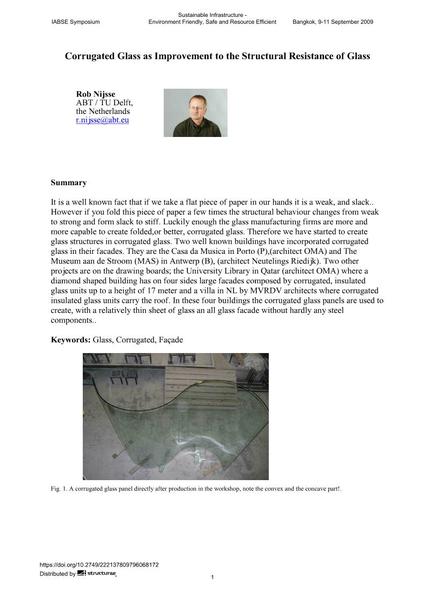Corrugated Glass as Improvement to the Structural Resistance of Glass

|
|
|||||||||||
Bibliographic Details
| Author(s): |
Rob Nijsse
|
||||
|---|---|---|---|---|---|
| Medium: | conference paper | ||||
| Language(s): | English | ||||
| Conference: | IABSE Symposium: Sustainable Infrastructure - Environment Friendly, Safe and Resource Efficient, Bangkok, Thailand, 9-11 September 2009 | ||||
| Published in: | IABSE Symposium Bangkok 2009 | ||||
|
|||||
| Page(s): | 73-85 | ||||
| Total no. of pages: | 13 | ||||
| Year: | 2009 | ||||
| DOI: | 10.2749/222137809796068172 | ||||
| Abstract: |
It is a well known fact that if we take a flat piece of paper in our hands it is a weak, and slack.. However if you fold this piece of paper a few times the structural behaviour changes from weak to strong and form slack to stiff. Luckily enough the glass manufacturing firms are more and more capable to create folded,or better, corrugated glass. Therefore we have started to create glass structures in corrugated glass. Two well known buildings have incorporated corrugated glass in their facades. They are the Casa da Musica in Porto (P),(architect OMA) and The Museum aan de Stroom (MAS) in Antwerp (B), (architect Neutelings Riedijk). Two other projects are on the drawing boards; the University Library in Qatar (architect OMA) where a diamond shaped building has on four sides large facades composed by corrugated, insulated glass units up to a height of 17 meter and a villa in NL by MVRDV architects where corrugated insulated glass units carry the roof. In these four buildings the corrugated glass panels are used to create, with a relatively thin sheet of glass an all glass facade without hardly any steel components.. |
||||
| Keywords: |
façade glass Corrugated
|
||||
